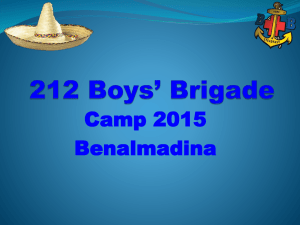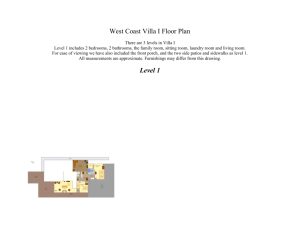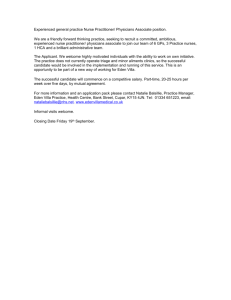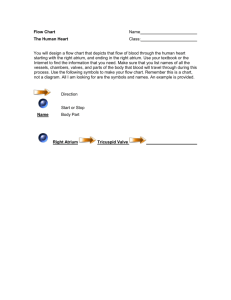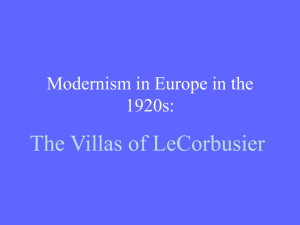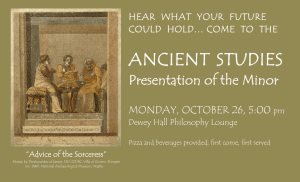Document 13552767
advertisement
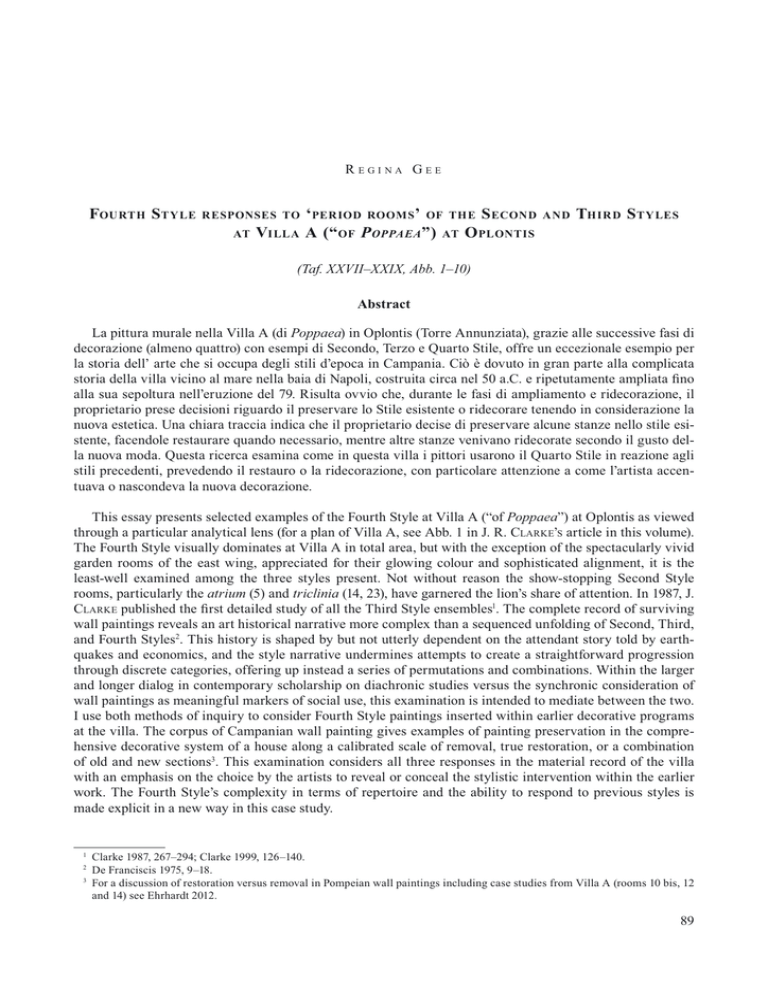
REGINA GEE
FOURTH STYLE
R ESPONSES TO
AT
VILLA
‘ PER IOD ROOMS’ OF THE S ECOND
A (“ OF P OPPAEA ”) AT O PLONTIS
AND
THIR D STYLES
(Taf. XXVII–XXIX, Abb. 1–10)
Abstract
}q (di Poppaea/ (Torre Annunziata), grazie alle successive fasi di
&/|=|
\#\¹
9^#\#
`p#'
|
##|
tuava o nascondeva la nuova decorazione.
=>|>q&Poppaea/ as viewed
>&q, see Abb. 1 in J. R. CLARKE’S article in this volume).
The Fourth Style visually dominates at Villa A?>
? ? $? > # ? ?$ | |>
>atrium (5) and triclinia&*_<ª/#*p+`J.
CLARKE
>=|>1#=
?|=
and Fourth Styles2#=>>>>>>?
#5
>>
???#
>|>?
#=\?hensive decorative system of a house along a calibrated scale of removal, true restoration, or a combination
of old and new sections3#=
?>>?
?#=|>>>>
??>>#
1
2
3
Clarke 1987, 267–294; Clarke 1999, 126–140.
De Franciscis 1975, 9–18.
?q (rooms 10 bis, 12
and 14) see Ehrhardt 2012.
89
Regina GEE
=|>>
? > 4. Villa A>>>category of the Fourth Style referred to by J. CLARKE => # \ ?&?/>?
?
estry” bands framing single centered motifs alternating with contrasting intervals holding candelabra"
aedicula ? ? 5. Villa A=?> > $ >6. There are also the afore?>7. In any
|>>?
>>#
???>
>|>>#>?>>q
|> M. SHAPIRO > > >
?>>>
>8. Style works struc>>>?$
?>9.
THIRD STYLE AND FOURTH STYLE IN ROOMS 17, 18 AND 8
In the section of the villa to the west of the north propylon entrance (21) is a set of rooms (17, 18 and 8)
>=|>?>
?10. Together they
?|>#'*`
the west of the north-entry axis, has characteristic early Third Style elements including slender decorative
> %> &#</#=>>#=?
?
#%>>?? ? ? ># = >
|>>??>??11. This lower zone makes
clear that in the work executed concurrently with the addition of the door, the decision was to insert a socle
???>>
? $$ $$ %> > =|>ª^<*#
4
5
6
7
8
9
10
11
90
=$j<;Vettii>>=>?q
\*pp*<<`¬}*pp*`++^#
=\*pp*j9j+¬}*pp*`*?>
#=$|>=>?
18, 24, 27, 33, 34, 37, 38, 40, 41, 66, 77 and 81.
==?ª*#=
?¬\$~<^^*`_+ª
#_ªj+¬}<^^ª*`j
#<^<ªL. CLINE in
this volume.
Bergmann 2002, 87–120.
|*pp_9ª#
=>>>>"&/#
=>
>%>=>#<^*#\#&>F. L. BASTET into 1a 20–10 B.C., 1b,
10–1 B.C.), or A. MAU candelabrum > > ? | = |> \
1987, 287.
>?\=<^^p<^*<^p#
|>|=|>q&Poppaea/
'*+>
=|>>&#ª/#*`
?>???#=??
?>|>#>
#=?>
?$
?#=?
>? > ? brown aedicula structures framing yellow-gold candelabra#=$>?
?>?>#|>
>?=|>?>?>&#_/#=?
? *` ª^# = ? >?>>
modern reconstruction12.
'+=|>?*+ª^> > # = |> > > ? %> # ? >$=|>#=|>$\?
"#=|>>?>>J. CLARKE in his
*pp*>?13#'+??>>
>?$>
?>#?>
the lower and middle zone continues the colours, layout and motifs of the side walls but with variations
|>&#_/#=
> ?>?
14#=?%>
>>?&/?
same motif, and its dimensions also change, becoming noticeably narrower in width. As on the north and
??|>>?$
??aedicula?>#
?$?cinct and Hercules?;>>?
#'+??>
*`#??>
?>>#=|>?tion cinnabar red and the stylistic variations, including the aedicula ? %>>
zone.
=>?> ? > ? ? ? ? > #'*`+?>>|>12
13
14
' *+ ? *< | = |> ???>$?>#
Clarke 1991, 128–130.
"&minium) Vitr. 7. 8–9.
91
Regina GEE
>>¬
>>>#>>>??
??#
SECOND STYLE AND FOURTH STYLE IN ROOM 5 (ATRIUM)
=
>|>?
>9||>atrium in Cam&#9/#=?
? ? > ? alae on the
Second Style, (H. G. BEYEN*`^9^\/#=?||>>>?>
>>>?>>????#
>>>>>?
?>
>cistae>?
#=atrium is also
> ? & ? *_ **/ >>?||>
the Villa of Publius Fannius Synistor15.
A careful look at the middle zone of the surviving east and west walls of the atrium makes a case for the
?|>||>>#
?>#=
>||>!# 5 > ?
?>
>?>ter (
or cotognino) and Numidian marble (giallo antico)16#=>>
>>||>
>#>¬?>?||>?
and from the comparandum>?qP. Fannius Synistor.
Within the Second Style rooms of Villa A?##
9^\*_\ (Abb. 6)17# >
??>?
#=
area and diameter; the width of individual rings also vary or waver in thickness from one section to the next;
>>?#??
| |> > ! ?
?#>15
16
17
92
E. LEACH||>q, Villa of P. Fannius Synistor (Boscoreale), and Casa del Labirinto?}*p+<*9*#qP. Fannius Synistor showing the
??¶}, Paris'>
de Mariemont?q>, Beaulieu-sur-Mer, and the Museo Archeologico
, see Bergmann 2010, 11–32.
?
>?$ury furnishings, see Leach 2004, 78.
Fant 2007, 338.
|>|=|>q&Poppaea/
baster columns from amphitholomos**?'~
the Villa of P. Fannius Synistor, which famously shares a number of the same decorative motifs of Villa A
atrium (Abb. 7)18#?
&>?>$?$/#>
{ > >??#=?
subtleties of shading from yellow ochre to dark brown effectively mimics the organic cream gold and brown
?#=atrium 5 at Villa
A, the initial observations are that the columns on the west and east sides are clearly by different hands, and
the artist of the set on the west wall is more skilful is getting visually closer to alabaster. In their own ways
>?
>||>?#\?>
?>?$>?&#+/#=>
???#$
#=$>
# = ? ?
although both are better executed in terms of creating a variegated surface. Recent chemical analysis of the
9***_<ª>P. BARALDI
9 # = $> > 9¬>>||>ined19.
>>>
>
> # q >
? > ?
||>#\>
> result20. When discussing the canonical four styles, scholars easily fall into the analogical use of language,
>>>#?
>?>>>
>>#5|>? > # = ||>>>#
=??
alabaster, was valued as soon as it was introduced into the Roman visual index of luxury in the 1st century
\#%?>
!&>ª</||>&*_??/=|>||>&*_?/
>|>|>&<`lararium base) in which it becomes a barely recogniz&#p/#
=>|>atrium of the villa
#}minum
||>
>#=>
18
19
20
}<^^_`+¬, Inv. s.n.v.1.
=>>P. BARALDI under my direction in the summer of 2011 is currently being
#
=>=|>?*_>
?{?$$$#
93
Regina GEE
? > >¬???>{#>>??
?21. The atrium of Villa A>??
>>?>>P. BARALDI22. On
the absence of cinnabar red in the atrium#=
of the Villa of P. Fannius Synistor??~cubiculum M and
> % 23. Additionally, every other surviving Second Style room
>>?q (14, 15, 11 and 23) has large sections of cinnabar red used in
#>
>alae on the southern
end of the atrium do not share the decorative system of the east and west wall. This in itself is not unusual,
?***_24#=?ala has a horizon>?$&#*^/25. In colour range and variega>
>atrium#%>
cant, and this is only observable by getting very close to the wall surface, the ala has cinnabar red in its dec#%
(Abb. 10).
=?
east walls of the atrium make a case for both as later versions of the original Second Style decoration. Additionally, the details of the east ala?atrium??ala
>||>>?#
CONCLUSION
>>>
>?>
>
?$?>#5>
'?q, style analysis entered from a different direction; it was
tories. Concerning the value of formal analysis and style art history in the study Villa A
#\
>
> 26. The case studies of Fourth Style
$q and elsewhere suggest a considerable effort by
?&/??
21
22
23
24
25
26
94
|||>q!&***_*9/cornices
&***_<ª/?&***_<ª/??"&*_*9<ª/opus isodomum?&*_<ª/&**9ala/&*9/#
=>q is forthcoming, Baraldi 2014.
|*9, Inv. s.n.1, s.n.2.
?atriumalae” although I believe
they are better understood as corridors. Each has a distinct Second Style decorative system I believe was originally visually
{?ala” is visually aligned to the north wall of room 11.
>??#
>>>>%<^^ª#
|>|=|>q&Poppaea/
??>#
arguing that the distinction between imitation and emulation, so well-chronicled by E. GAZDA in reference to
?>?27. I am
? ' ? ? ? > >?>
?>#
Bibliographie
*pp^
<^*<&/
<^^<
<^*^
\*p+`
\*pp*
\=<^^p
\~<^^*<^^<
*p`9
Ehrhardt 2012
Elsner 2003
<^^`
~<^^<
}<^^ª
}*p+<
}<^^_
Ling 1991
|*p9ªÐ*pp_Î
27
5# \# = \ q
|>p_*pp^p9*<ª#
# > ! # '# \ |# \ # = &#/ q &
/ &= >/ q# # % |
|&?¶<^*</#
#!=#~#
;>>;
'#_`<^^<+`*<^#
# ? q |> ! #
Bergmann – S. De Caro – J. R. Mertens – R. Meyer (eds.), Roman Frescoes from Boscoreale. The
Villa of Publius Fannius Synistor in Reality and Virtual Reality (New York 2010) 11–32.
#'#\=%>=|>'p_*p+`<j`<p_#
# '# \ ; ' > *^^ \## <9^# ' | &>
1991).
#'#\#=%'q&q
/##_9'<<<^^p<^*<^p#
\# \ ~ = @$| # ' 5 >'|*<*ª, 2001–2002, 53–94.
# } ! # ;# > &;#/ {q`p\#|
%***_#*p`ª&'*p`9/p*+#
W. Ehrhardt, Dekorations- und Wohnkontext. Beseitugung, Restaurierung, Verschmelzung und
5<j&5
2012).
J. Elsner, Style, in: R. S. Nelson – R. Schiff (eds.), Critical Terms for Art History, (Chicago 2003)
98–109.
\#'&/!#&#/=5
'?&}'<^^`/ªªjª_j#
%# ~ > \># > = ! %# ~ = %# | > = \ >
|#*<^^<*<_#
}# } @ \ ? # `+ <^^ª
167–189.
%#5}#=>>'$\
and the Transition from the Second to the Third Style, in B. Gold (ed.), Literary and Artistic
Patronage in Ancient Rome (Austin 1982) 134–173.
%#5#}=|}'>&\
2004).
R. Ling, Roman Painting (Cambridge 1991).
# | => > # |> |> &? ¶ Ð*p9ªÎ *pp_/
51–102.
Gazda 2002, 1–24.
95
Regina GEE
Abbildungen
Abb. 1: Villa A&/'*`?&P. BARDIGY>{/
Abb. 2: Villa A&/'*+??=|>&>P. BARDIGY and author,
>{/
Abb. 3: Villa A&/'+?&P. BARDIGY>{/
Abb. 4: Villa A&/?=|>'*`*++&C. FIELD)
Abb. 5: Villa A&/'9?&P. BARDIGY>{/
Abb. 6: Villa A&/'*_&/
Abb. 7: Villa A &/ ' ** ? & P. BARDIGY >
{/
Abb. 8: Villa A&), Room 5 (atrium/?&/
Abb. 9: Villa A &/ ' ª< ' *_ ? ? | |>
'*_?=|>||>'<`
side of the lararium|>&>P. BARDIGY>{/
Abb. 10: Villa A &), Room 5, north wall of east ala &/
Regina Gee
College of Art and Architecture, School of Art
P.O. Box 173680, Bozeman, MT 59717-3680
rgee@montana.edu
96
